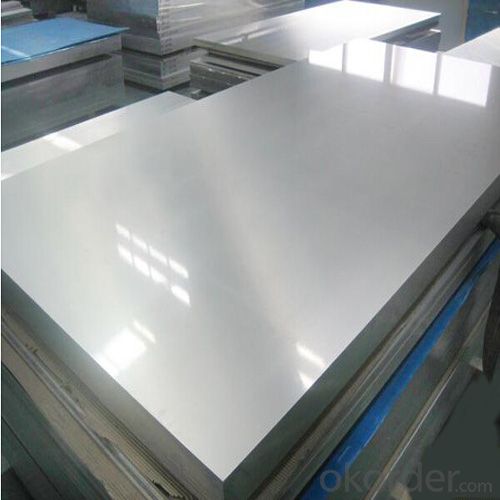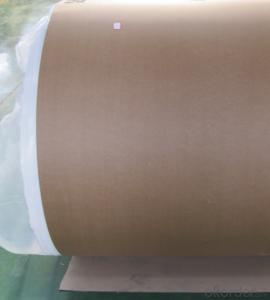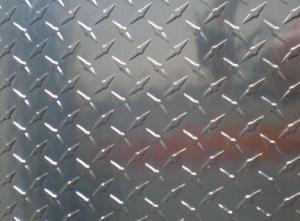Aluminum Perforated Sheets Thin - Decorative Cloverleaf Pattern
- Loading Port:
- Shanghai
- Payment Terms:
- TT OR LC
- Min Order Qty:
- 5 m.t.
- Supply Capability:
- 10000 m.t./month
OKorder Service Pledge
OKorder Financial Service
You Might Also Like
Specification
1.Structure of Perforated Metal Decorative Cloverleaf Aluminum Sheet Description:
Perforated Metal Decorative Cloverleaf Aluminum Sheet are widely used for building use, decoration use, making cookware, busing making, shipping building, airplane making and so on。Sizes of aluminum sheet for decoration use: Thickness: 0.3mm~300mm Width: Under 2000mm ( Standard: 1000mm, 1219mm, 1500mm, 1540mm) Length: Under 10000mm. Products commonly used in signs, billboards, building exterior decoration, bus body, high factory wall decoration, kitchen sink, lamp, fan, electronic components, chemical apparatus, sheet processing, deep drawing or spinning hollow ware, welding parts, heat exchangers, Bell surface and plate, plates, kitchen utensils, accessories, safety equipment and other.
2.Main Features of Perforated Metal Decorative Cloverleaf Aluminum Sheet:
Good mechanical properties.
Easy processing, wearability.
Corrosion resistance
Resistance to oxidation.
3. Perforated Metal Decorative Cloverleaf Aluminum Sheet Images:



4. Perforated Metal Decorative Cloverleaf Aluminum Sheet Specification:
| Aluminium sheet | |||||
| Alloy No. | Thickness (mm) | Width (mm) | Length (mm) | Temper | |
| A1050,A1060, A1070,A1100 | 0.2-100 | 20-2200 | 20-8000 | O,H12,H22,H14,H16,H18, H24,H26,etc | |
| 3A21,A3003,A3105,A3004 | 0.2-100 | 20-2200 | 20-8000 | O,H14,H18,H24,etc | |
| A5052 ,A5005,A5083,A5754 | 0.2-100 | 20-2200 | 20-8000 | O,H18,H24,H32,H34,H111,H112 ,etc | |
| A6061,A6082,A6063 | 0.2-200 | 20-2200 | 20-8000 | T4,T6, T651,etc | |
| A8011 | 0.2-100 | 20-2200 | 20-8000 | O,H12,H22,H14,H16,H18,H24,H26, etc | |
5.FAQ
1.Q: What about leadtime ?
A: Normally the leadtime is 60days after we receive the deposit and confirm the details. All the press machines we use is the best quality in China Yangli brand. The press machine leadtime from Yangli is 50days, the best leadtime we can give is 60days.
2.Q: What's the lead time for moulds?
A: Normally the mould leadtime is 45 days after we confirm all the details with customer. Our professional mechanical enginners from Austria will design the mould according to the samples from customer, or by the specifications offered by customers.
3.Q:What kinds of mould you can make? and what is your strong point for the moulds?
A: we can make wrinkle wall mould and smooth wall mould both. For wrinkle wall mould we can make, 79" pan, fish pan, bbq pan. For smooth wall mould we can make muffin cup, and cake cup, tar cup,etc. We can also make 2 or 3 portion conatiner moulds as long as you offer us sample or specifications. Our strong points are all our moulds are WEDMLS cut, which makes the mould more accurate and precise. Important materials likestainless steel parts we make in Austria. We also recut after heat treatment, which most of makers do not take this process..
- Q: General characteristics of pure aluminium plate of pure aluminium plate
- I really want to know to call 1362889760 for your reference as follows: according to the content of different aluminum alloy elements can be divided into 8 series respectively 1***, 2***, 3***, 4***.5***.6***.7***.8*** according to the different processing technology can be divided into cold and hot rolling. They can be divided into thin plate and medium plate according to their thickness. GB/T3880-2006 standard specifies a thickness of 0.2 millimeters, called aluminum foil. More commonly used grades: pure aluminum plate, 1060 plate. Foil. Thick plate, tensile tube. Extruded tube. Type. Bar. Cold processing bar mainly for corrosion resistance in forming of high places, but not of high strength components, such as chemical equipment, marine equipment, railway tanker, conductive materials, instruments and materials, electrode etc.. 3003: plate, strip. Foil. Thick plate, tensile tube. Extruded tube. Type. Bar. Wire rod。 Cold bar, cold wire, rivet wire, forging, foil, heat sink material mainly used for processing requires good molding property, high corrosion resistance, good weldability or parts, or both have these properties need than the workpiece of 1*** alloy with high strength, such as the transport of fluids tank and tank, pressure tank, storage device, heat exchanger, chemical equipment, aircraft fuel tank, oil pipe, reflective panels, kitchen equipment, cylinder washing machine, rivet, wire. 3003 aluminum alloy sheet, plate, tube drawing. Extruded tubes, houses, partitions, roof covers, piping, etc. 3004 plates, thick plates, tensile tubes.
- Q: How much is one ton of aluminium plate?
- Aluminum sheet is more than 0.2mm thickness, 500mm, 200mm width, length of less than 16m aluminum material called aluminum sheet or aluminum sheet, 0.2mm below is aluminum, 200mm within the width of row or strip material! Aluminum prices look at what specifications you want, what material, you can consult the Guangdong Hon Hai metal
- Q: Is it possible to construct furniture using aluminum sheets?
- <p>Yes, you can use aluminum sheets to make furniture. Aluminum is a lightweight, durable, and corrosion-resistant material that is often used in modern furniture design. It can be easily shaped and welded, making it suitable for a variety of furniture pieces such as tables, chairs, and shelving. However, it's important to consider the design and structural integrity, as well as the finish and comfort, when creating furniture with aluminum. It's also advisable to use appropriate tools and techniques to ensure safety and quality in the construction process.</p>
- Q: Are there any specific storage requirements for 101 aluminum sheets?
- Yes, there are specific storage requirements for 101 aluminum sheets. It is important to store them in a dry, clean, and well-ventilated area to prevent any moisture damage or contamination. Additionally, they should be stored in a horizontal position to avoid warping or bending.
- Q: What are the different methods of surface coating for aluminum sheets?
- Aluminum sheets can be coated using various methods, each with its own unique benefits and applications. Some commonly used methods include: 1. Anodizing: By immersing aluminum in an electrolytic solution, a protective oxide layer is formed on its surface. This process enhances corrosion resistance, durability, and can be used for decorative finishes. 2. Powder coating: Dry powder is applied to the aluminum surface and then cured through heating. This method provides a durable and attractive finish, with excellent resistance to abrasion, chemicals, and UV rays. 3. Painting: Conventional liquid paints can be used to coat aluminum sheets, allowing for customization and offering good corrosion protection. However, this method may not be as durable as others. 4. Cladding: A protective layer, such as stainless steel or other metals, is bonded onto the surface of the aluminum sheet. This provides superior protection against corrosion, impact, and extreme weather conditions. 5. Laminating: A thin layer of protective material, such as PVC or PET film, is applied to the aluminum sheet. This enhances resistance to scratching, staining, and fading, making it suitable for applications requiring long-term durability. 6. Chemical conversion coating: The aluminum surface is treated with a chemical solution to create a thin, protective layer. For example, chromate conversion coating enhances corrosion resistance and improves paint adhesion. 7. Electrophoretic deposition (EPD): The aluminum sheet is immersed in a water-based paint solution, and an electric current is used to deposit the paint particles onto the surface. This method provides uniform coating thickness and excellent corrosion resistance. Each of these methods has specific advantages and is suitable for different applications. The choice of method depends on the desired properties, aesthetics, and intended use of the aluminum sheets.
- Q: This question asks for a guide on the correct procedure to install aluminum sheets, likely for construction or renovation purposes.
- <p>To install aluminum sheets properly, follow these steps: 1. Prepare the surface by cleaning and leveling it. 2. Measure and cut the aluminum sheets to the required size using a metal saw or tin snips. 3. Apply a bead of construction adhesive along the edges of the surface where the sheets will be placed. 4. Position the aluminum sheet, ensuring it's aligned correctly. 5. Secure the sheet with screws or nails, using a washer to prevent tearing. 6. Seal the seams and edges with a weatherproof sealant to prevent water ingress. 7. Inspect the installation for any gaps or unevenness and make adjustments as needed. Always follow the manufacturer's guidelines and safety precautions while working with aluminum sheets.</p>
- Q: Can aluminum sheets be bent without breaking?
- Aluminum sheets possess the remarkable ability to endure bending without shattering. As a metal, aluminum boasts exceptional malleability and ductility, rendering it effortlessly moldable and pliable. This quality renders aluminum an optimal substance for a wide array of purposes, encompassing the production of aircraft, automobiles, and household articles. The pliability of aluminum sheets facilitates the crafting of intricate designs and intricate forms, establishing it as an exceptionally adaptable substance. It is, nonetheless, worth mentioning that the thickness and caliber of the aluminum sheet may impact its susceptibility to bending. Thicker sheets may necessitate increased force and specialized tools to achieve the desired curvature, whereas softer aluminum grades may yield to bending with greater ease.
- Q: Are aluminum sheets suitable for automotive body framing?
- Yes, aluminum sheets are suitable for automotive body framing. Aluminum is lightweight, corrosion-resistant, and offers excellent strength-to-weight ratio, making it an ideal choice for reducing vehicle weight and improving fuel efficiency. It is commonly used in modern automotive manufacturing for body panels and frames, providing structural integrity while maintaining durability.
- Q: I was quoted $5000+ to upgrade my house from 100A electric service to 400A. Part of the reason for the high cost is the cost of copper. What size copper wire is needed for 400A, and how much does it cost per foot? Would it be a lot cheaper to use aluminum wire?
- Oh come on!! The question seems to be asking abotu replacing the service ENTRY cable to bump it up from 100 to 400 AMPS. Got news for you all. THe service entrace cable IS aluminum. It connects to the circuit breaker box at terminals designed FOR aluminum. Go take a look at any recent install and tell me what you see. (It will be AL) AS for the remainign wires throughout the house. Most will be copper. However note that modern outlets can be provided to accept aluminum and copper. Just look fot the AL/CU stamp ont he outlet. Generally the clothes dryer, over and A/C will use al wire but they are attached to outlets specifically designed for AL wire. Eric
- Q: Can aluminum sheet be used for cookware?
- Yes, aluminum sheet can be used for cookware. Aluminum is a popular choice for cookware due to its excellent heat conductivity and lightweight properties. However, it is usually combined with other materials, such as stainless steel or non-stick coatings, to enhance its durability and prevent any potential reactions with certain foods.
Send your message to us
Aluminum Perforated Sheets Thin - Decorative Cloverleaf Pattern
- Loading Port:
- Shanghai
- Payment Terms:
- TT OR LC
- Min Order Qty:
- 5 m.t.
- Supply Capability:
- 10000 m.t./month
OKorder Service Pledge
OKorder Financial Service
Similar products
Hot products
Hot Searches
Related keywords




























